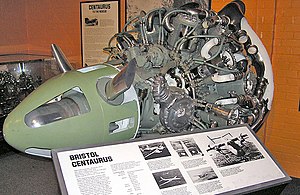Bristol Centaurus
| Centaurus | |
|---|---|
 |
|
| Preserved Bristol Centaurus engine | |
| Type | Piston aircraft engine |
| Manufacturer | Bristol Aeroplane Company |
| First run | July 1938 |
| Major applications |
Hawker Tempest Bristol Brabazon Hawker Sea Fury |
| Number built | c.2,500 |
The Centaurus was the final development of the Bristol Engine Company's series of sleeve valve radial aircraft engines, an 18-cylinder, two-row design that eventually delivered over 3,000 hp (2,200 kW). It was introduced into service late in World War II, and was one of the most powerful aircraft piston engines to see service.
The Royal Navy Historic Flight currently operates a Hawker Sea Fury, powered by a Bristol Centaurus.
Like most Bristol Engines designs, the Centaurus was based on the mechanicals of an earlier design, in this case the "classic" 5.75 in (146 mm) piston from their original 1918 Jupiter. The Jupiter piston was still in use in the contemporary 14-cylinder Hercules, which was being brought into production during the design of the Centaurus.
The Centaurus had a cylinder swept volume of 3,272 in³ (53.6 l), close to that of the American Wright Duplex-Cyclone large radial, making the Centaurus one of the largest aircraft piston engines to enter production, while that of the Hercules was 2,363 cubic inches (38.7 l). The nearly 40 percent higher capacity was achieved by increasing the stroke from 6.5 to 7 in (170 to 180 mm) and by changing to two rows of nine cylinders instead of two rows of seven but the diameter of the Centaurus was only just over 6 percent greater.
The cylinder heads had an indentation like an inverted top hat, which of course was finned but it was difficult to get air down into this hollow to adequately cool the head. During the development stage the engineers contacted ICI Metals Division, Birmingham, to enquire whether a copper-chromium alloy with higher thermal conductivity, would have sufficient high temperature strength to be used for this purpose. Tests were successful and with the same volume of cylinder, these modified heads enabled the horsepower per cylinder to be raised from 110hp to 220hp.
Bristol maintained the Centaurus from type-testing in 1938 but production did not start until 1942 owing to the need to get the Hercules into production and improve the reliability of the entire engine line. Nor was there any real need for the larger engine at this early point in the war, when most military aircraft designs were intended to mount engines around 1,000 hp. The Hercules' approximately 1,500 hp was better suited to the existing airframes.
...
Wikipedia
